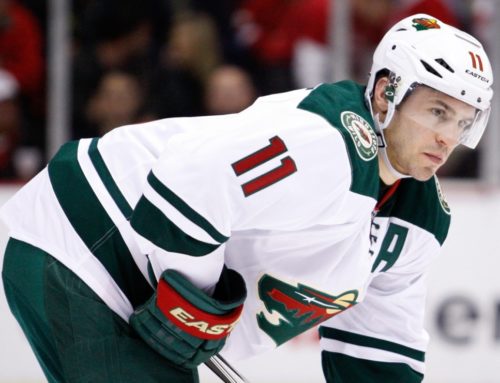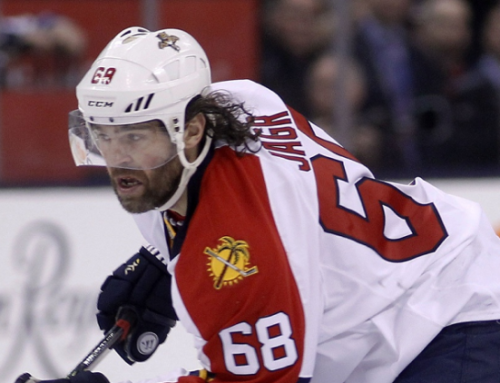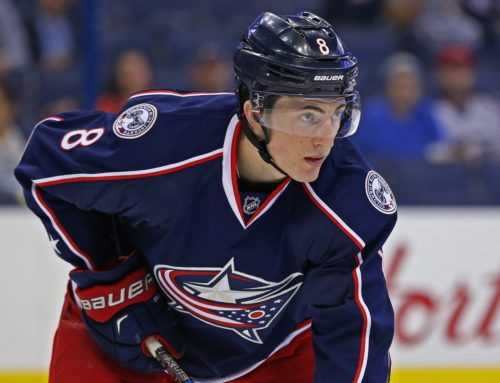The Contrarian – Words and Numbers
Dobber Sports
2014-01-26

Don’t ignore other evidence when using statistics in fantasy evaluations.
Today I am going to detail my arguments against The Power of Numbers, an article written by Ryan Ma. After this, I promise to drop the matter.
Before I step into my arguments, there are some things from last week’s article that need clarification, as they weren’t intended to offend.
“Pulling wool over eyes” … is intended towards the great deal of emphasis that Ryan places on the covariance coefficient value and what he calls the most important three factors. Do you need a value to tell us that a player has more opportunity to score if he a) gets more power play time, b) they shoot more and c) they have more ice time? I underline the word opportunity because I want there to be a clear distinction that there is no guarantee for point production whereas I get the feeling from Ryan's article that due to normalization the points will eventually be generated. Not only do I think the covariance coefficient value is not needed I believe that it is skewed.
“Gambler's Fallacy”… it is not my idea. A link to the wiki page can be found here. We do not get to decide when, if at all, normalization will occur.
“Brain-dead logic”… I apply it to all of us, including myself, when we fall into the Gambler's Fallacy. I repeat that I am not immune.
“Graphs” … I appreciate that Ryan attempted to place Points on the same axis for all the graphs but due to excel issues was not able to do.
Now onto my case, for consistency I will be using the data found within Ryan's pdf file for forwards.
First, I call upon Alexander Ovechkin.
![]()
Those are huge stats with 11476 seconds of power play time and over 200 shots, the best of all the forwards.
Do we recall what Ryan says? The strongest correlation co-efficient value is the one for PPTOI. The second strongest was shots on goal.
We are looking at the best player in both those categories. So where would you expect him to rank amongst all other forwards in terms of point production? First? Second? Go ahead and take a look at the pdf file.
He didn't even crack the top ten forwards! He is 19 points behind the leader, Sidney Crosby.
Ryan doesn't try to understand why Ovechkin didn't rank as the best player after all those games, he just holds onto normalization and says that he is a good buy candidate. Understanding what went wrong is not part of the equation.
With half a season gone, those huge correlation co-efficient values would not be making me feel very happy if I had drafted Ovechkin early in a draft this season.
Next, I call on his teammate Nicklas Backstrom.
![]()
Backstrom, with a significant fewer shot total by more than half, with 2,000 seconds less of power play time but approximately the same amount of playing time has more points than Ovechkin.
Oh Demetri, you are such a nitpicker. Four points difference. What is your point?
The two biggest factors as per Ryan's article do not seem to be the biggest factors or else we would have seen Ovechkin with significantly more points. I specifically look at Backstrom because he plays on the same team as Ovechkin and he gets only 70.9% of the team's power play time. Ovechkin gets 94.3%.
Backstrom does make the list of top five forwards though.
I now call upon Logan Couture.
![]()
Power play time and overall time on ice are comparable to Backstrom's stats. His shot total is higher by 51 shots. How is it that he has 13 fewer points than Backstrom?
Couture was ranked 43rd among all forwards at the time. Why isn't he a buy candidate or conversely why isn't Backstrom a sell candidate? (Yes, I am aware that Couture is hurt at the moment. The question is rhetorical)
Powerful stuff these numbers are indeed.
Dustin Brown, please come forward.
![]()
I bring Brown up (ranked 209th among all forwards) to look at what Ryan does not – why his first half production did not match his previous career levels. To me, Ryan seems disinterested in finding out why he started out so badly this year but very interested to say that his statistical numbers look good and he should get a good bump in the second half.
A quick scan of his news within The Hockey News site under his player profile reveals the following:
On September 13, 2013, Dustin Brown suffers minor hamstring injury, LA Kings Insider
On September 23, 2013, Dustin Brown did not participate in practice Sunday due to a hamstring injury, LAKings.com
Same day, Dustin Brown may not start season on time, Lisa Dillman on Twitter
Under Impact, "He hasn't played any exhibition games and he's [been] in one team practice since the start of camp. Coach Darryl Sutter isn't sure if Brown will be available for the regular season opener. "If he doesn't get any exhibition games, I'd say it's highly unlikely that you've got a player that's ready for the season," said Sutter.
September 28, 2013, Dustin Brown set to play in preseason finale, LA Kings Insider
Under Impact, "It's good. It felt pretty good for a week or so now, and getting into the on-ice stuff," Brown said referring to the ailment "[Saturday], I think, will be good just to get hit and hit, just get the body ready for the next 82 games. The only thing I feel is probably the bruising is still there, but it's just like any other bruise. It's going to hurt until it's gone. But the actual muscle feels good."
October 1, 2013, Dustin Brown is rusty going into 2013-14, Los Angeles Times
Under Impact, "My conditioning, the physical part is OK," said Brown. "It was the little puck plays, a couple plays where I mishandled it or didn't make a touch pass I can make nine times out of 10. I've missed training camp and it shows."
October 7, 2013, Dustin Brow dusting off the rust in early on, Los Angeles Times
"I felt a lot better in Winnipeg that I did in Minnesota," Brown said. "I'm sure I'll feel a lot better getting a couple of days' rest. … I'm sure I'll be right where I need to be, just getting in games. Practices are one thing, but it's the timing of games. For me I was happy we had back-to-back." Brown is also wearing a knee brace due to the injury suffered in last season's playoffs.
December 1, 2013, Dustin Brown continues to struggle, LAKings.com
Under Impact, Brown has contributed with a plus-10 rating and 22 penalty minutes in 27 games but fantasy owners expect a lot more than four goals and nine points at this stage of the season. He is a good buy-low candidate at this time.
January 4, 2014, Dustin Brown unhappy with his play, LAKings.com
Under Impact, "If I can pick my game up and elevate my game – I'm sure there's other guys who feel the same way – our team is going to get better," Brown said. "For me, it's just about getting my game back, and a lot of it's just details for me. So I've got to focus on those from game to game and be ready to go."
Looks like he is still playing hurt or at a bare minimum he is finding it hard to keep up with everyone else. When Drew Doughty missed all of training camp holding out for a new contract he went through a bad season too.
Not a statistic but it is information. Information that can be useful in forecasting his point totals for the rest of the season.
I also want to point out that on December 1, 2013, he was listed as a good buy-low candidate by LAKings.com. Since that point in time to the time captured in Ryan's data file, he got four points in 13 games. A 0.307 points per game pace during that span of time.
I've got one more individual player to bring up but right now I want to call on all the forwards that have been plotted and evaluated.
I did this by hand, by my count there are 514 forwards. The average player got 12.7 points, the median point was 10 points and the mode was zero. Meaning more forwards got a value of zero than any other value.
With more than half the players getting 10 or fewer points, I suggest that the correlation co-efficient value is skewed to be so huge because the majority of players a) do not get many points, b) do not get much time on the power play and c) do not get as many shots.
That was my point about the values being denser at the lower end of the scales and sparser at the higher end.
For my final player I call upon Scott Gomez. For this I am using his career stats including his current statistics.

*Dobber’s projections were obviously done prior to the given season starting
I bring him up to compare apples to apples because I think some of you won't like my earlier comparisons of Ovechkin, Backstrom and Couture. So I am comparing Gomez to Gomez. (I do not have power play time on ice stats)
He burst on the scene in the 1999-00 season and got a smashing 70 points. With similar TOI and shot totals to his rookie year, in the 2002-03 season, he earned 55 points. I ask, If Ryan says that two of the most important indicators are TOI and shots, why the difference of 15 points? In 2005-06, Gomez’s TOI and shots increase and he has the best year of his career, tallying 84 points. Hey maybe Ryan has something here.
So why does he not reach that same point level in later seasons, especially in 2008-09 when he earned the most ice time of all his season and also the most shots? He comes short by 26 points. So why such a fluctuation in his totals? The statistics were supposed to normalize. Are the numbers lying? Gomez may be an exception to the analysis, but he’s one of many.
There are more than three key factors to point production and even Ryan admits to this in one of his responses to my original column. Under the response titled "Beene Counters" he says, "There are a multitude of factors that play into scoring and production."
That is how I rest my case but before I end this article I will briefly address a secondary item, the topic of what I think could improve his system.
Ryan has taken much time and effort to come up with something. I appreciate that and from what I have read there are many others who enjoy his efforts in that regard. My efforts in these two articles were to point out the weaknesses (at least those perceived by me). I saw "Power of Numbers" and "most important factors" and felt it was incomplete. Ryan is absolutely correct in wondering why I did not offer up a better suggestion. So I will do so now. It involves augmenting his method with the following.
First, find a way to get rid of the lower-end players and not stress so much about the co-efficient value. Second, see if you can break your evaluations into top tiers like Austin Wallace did with his fantasy rankings. Compare the elite to the elite, and so on. Lastly, seek to find out why things didn't work out in the first place.
Words and numbers, living together in harmony. Imagine that.





 MIN
MIN SEA
SEA WPG
WPG VAN
VAN CGY
CGY S.J
S.J COL
COL EDM
EDM VGK
VGK ANA
ANA L.A
L.A CHI
CHI MTL
MTL TOR
TOR PIT
PIT NYI
NYI WSH
WSH CBJ
CBJ ARI
ARI
